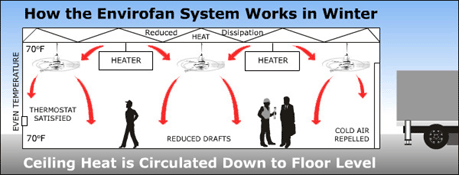
The effectiveness of an Envirofan system for winter heating is based on the simple concept of heat stratification. That is, within a closed space heavier cold air drops to floor level while lighter warm air rises to the ceiling. As a
Envirofans equalize room temperature by pushing down and mixing wasted ceiling heat with the cooler air below. The thermostat stays satisfied for longer periods of time and can be set at the actual desired temperature level. People will be more comfortable and productive. In high ceiling areas like warehouses, thermostats can be cut 5-10 degrees after installing an Envirofan system, yet floor temperatures will still increase.
Best of all, statistics from the utility industry show that the resulting savings in heating costs can be as high as 30%. For every degree the ceiling temperature is lowered by destratifying heat with ceiling fans there can be a 3% savings in energy costs. With energy savings like that an Envirofan system can pay for itself in the first year!
It takes a high quality, powerful industrial motor and efficient blade design to create enough air movement for results like these . . . it takes ENVIROFAN!

